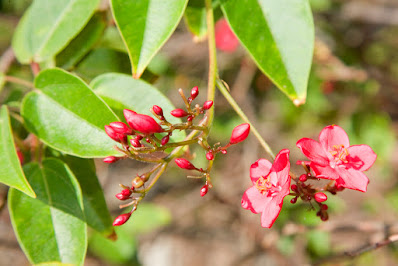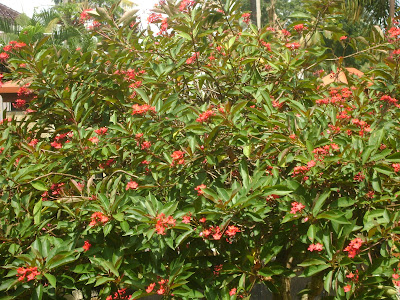Jatropha integerrima - Peregrina - Spicy jatropha is found growing in sandy and semi-arid areas, close to swampy zones and in disturbed soils...
Jatropha integerrima, also called as Peregrina, Spicy jatropha, Adenoropium hastatum, Adenoropium integerrimum, Adenoropium pandurifolium, Jatropha acuminata, Jatropha coccinea, Jatropha diversifolia, Jatropha diversifolia var. pandurifolia, Jatropha hastata, Jatropha integerrima var. coccinea, Jatropha integerrima var. hastata, Jatropha integerrima var. latifolia, Jatropha moluensis, Jatropha pandurifolia, Jatropha pandurifolia var. coccinea, Jatropha pandurifolia var. latifolia, is a species of the genus Jatropha. This species was described by Nikolaus Joseph von Jacquin in 1763.
IDENTIFY JATROPHA INTEGERRIMA - PEREGRINA - SPICY JATROPHA
Jatropha integerrima is native to Cuba. It is found growing in sandy and
semi-arid areas, close to swampy zones and in disturbed soils. It is widely
grown for ornamental in many tropical and subtropical countries and often
persistent after cultivation.
Peregrina is a shrub to small tree which grows up to 15 ft tall with a spread of about 10 ft (usually smaller in cultivation) with several slender trunks, but it can also be pruned into to a single trunk. The leaves are very variable, up to 7 inches long. They may be entire and elliptic or oval, or they may be fiddle shaped, or they may have three sharp pointed lobes. Leaves are bronze when young and brownish on the undersides.
Spicy jatropha blooms in late spring and summer from the multi-flowered terminal cymose inflorescence at the branch tips with clusters of flowers. The flowers are star shaped, five-petaled, about 2.5-3 cm across, bright scarlet, vermilion or coral-red with yellow stamens. The inflorescence continues to branch and flower for an extended period.
JATROPHA INTEGERRIMA - PEREGRINA - SPICY JATROPHA CARE AND CULTURE
Cultural information should only be used as a guide, and should be to be adapted to suit you. Your physical location; where you grow your plants, how much time you have to devote to their care, and many other factors, will need to be taken into account. Only then can you decide on the cultural methods that best suit you and your plants.
Light:
Jatropha integerrima thrives in bright, direct sunlight. The sunnier the area, the happier the plant will be. Insufficient amounts of sunlight will cause the plant to grow lanky with light green leaves. It can also cause only a few pale colored flowers to be produced, if any at all.
Temperature:
Peregrina are hardy in USDA zones 10 and 11. In others zones your plant can live outside in summer and come inside for the winter. Alternately, with at least five to six hours of sunlight daily, the plant will bloom indoors. Place the plant next to a sunny window, but away from drafts caused by air conditioning vents. The plant prefer temperatures between 18 - 26 ° C. When temperatures drop below 10 ° C, the plant will drop its leaves and go dormant. The stems can rebound from the base from temperatures that go lower and potted plants can be put in shelter over winter to rebound rapidly when placed outside in spring.
Humidity:
Moisture levels are important and the plant needs change as the seasons change. When in active growth, like during spring and summer, they will need average moist to moderately moist. Providing good air circulation will also help to reduce the chances for diseases or insect infestations to take hold.
Substrate and growing media:
Spicy jatropha is noted as having a good level of tolerance to saline conditions and a wide range of soil pH tolerance so long as the soils are well drained. The ideal soil mix would consist of loam and humus (organic) material, dirt and aggregates. The loam and humus with the dirt will give the mix structure and texture. This will optimize the usage of the fertilizer when given, thus enhancing the overall growth. Fast drainage is imperative, especially for younger plants. Use a substantial amount of aggregates for aeration and support for the roots–at least 30% of soil mix. Clay-type soils may be combined with store bought conditioners or potting soils.
A small amount of horticultural charcoal can be added to any of the above mixes in order to improve drainage. Also, after a sufficient amount of media has been placed in the bottom of the pot, 2-3 tablespoons of bone meal or blood meal can be mixed into the media before the rooted plant is placed in the pot.
When growing the plant as a container plant it is important to make sure that the container and root ball are heavy enough to prevent a good wind storm from blowing it over and ultimately breaking the plant. You may want to consider tying it off to a good support if that is at all in question. Plunging the container into the ground is another method where container and all are planted in the spring. This provides good support for the plant, as well as giving the roots a chance to utilize moisture and nutrients from the garden soil and still gives you an easy way to transplant it in fall with minimal shock. If planting or plunging the plant into the ground in spring you will want to wait until daytime temperatures are sufficiently warm and all danger of frost has passed.
Repot as needed in late winter, either root-pruning for planting back into the same container, or replant the intact root ball in a larger container.
Watering:
During the growing season, a once-weekly watering is usually sufficient, unless the plant is potbound. The media should be allowed to dry out slightly between waterings. Over-watering is a common mistake, when in doubt, don't water. A thirsty plant will quickly recover, but a plant afflicted with rotting roots due to over-watering can be difficult to salvage.
When you do water, water thoroughly to fully saturate the entire root ball of the plant but remember to let the top 1” or so of soil to dry out between waterings. In late fall, once the foliage starts to drop, you can reduce watering frequency and in winter when they are completely dormant very minimal to no water is required on the deciduous types.
Fertilizer:
During the first two years of a young plant's growing season, a fertilizer formulation of 10-30-10 will be fine. The development of strong adventitious roots is very important at this stage of the plants’ life. After roots are well established, a balanced fertilizer of 20-20-20 or 13-13-13 will do fine. These fertilizers will allow the mature tree to produce larger, healthier flowers in greater numbers. It is always better to feed at a 'low and slow' rate – meaning, less than the recommended dosage over a longer period of time. One-shot highly concentrated dosages will burn the roots and in turn, eventually kill the plant.
Winter period:
Jatropha integerrima can goes through a dormant period during the winter season. It drops its leaves and shows no sign of external growth. However, this period of low light and low temperature enables the plant to gradually prepare itself internally for the next growing season. In early spring, a burst of new foliage will appear. The inflorescence will closely follow in late spring and through summer.
Dormant plant do not require watering, but it may be necessary to occasionally mist the trunk due to the lower humidity of household air over the winter. Plants placed in the kitchen or bathroom may not need misting as the higher humidity of these rooms will help prevent desiccation of the trunk. The plants should be kept at a temperature of not less than 10 ° C during the dormancy period.
Pruning:
Prune to remove dead branches and leaves for a cleaner appearance in the landscape. However if it's not pruned on a regular basis it will grow out of control. As a large bush it becomes top heavy with growth and flowers and barren of them at the bottom (very leggy looking). Repeatedly prunings also help to encourage new growth. The flowers only develop terminally (at the end of a stem), so a good ramification (plants presenting many branches) produces the greatest amount of flowers. Prune preferably in spring by one-third to keep growth compact, but as Peregrina blooms on the current year's growth it can be pruned at any time of the year. Easy to prune to desired shape and height. You may also remove the lower branches to convert into a small tree or used in espalier.
Pests and diseases:
Peregrina have few problems, but can be infested with common greenhouse pests such as white flies and mealybugs, and are very susceptible to spider mites. Insecticidal soap can be used to control these pests.
Propagation:
Jatropha integerrima are usually propagated from stem cuttings. Take at least 18 inch and have a minimum of four nodes cuttings of leafless stem tips in spring, and allow the cut end to dry before planting. The cuttings are susceptible to rotting during the rooting process. It is advisable to dip the cutting in softwood rooting hormone containing an anti-fungicide prior to planting. Put the cutting into a container of damp sawdust, coco core or peat moss in a sheltered setting such as a planting tunnel or greenhouse. You must keep the cutting warm between 77° – 86° degrees Fahrenheit (25° C – 30° C) with a high level of humidity 70% to 90%. Keep the planting substrate moist but not saturated. The cutting should begin developing roots within 7 – 10 days. Rooted cuttings can then be transplanted into a more nutritious media.
The plant can also propagated by seeds. Prepare the seeds by soaking them in warm water for eight hours before planting. Plant directly into the soil outdoors in a sunny location. The soil should consist of equal parts of sand, garden soil, and aged manure. Don’t bury the seed deeply, instead press it into the surface of the amended soil. Water frequently (two times daily) for the first week. Shoots should appear within six days. Reduce watering to once daily until the seedlings are ready to be transplanted.















COMMENTS